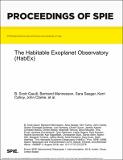| dc.contributor.author | Seager, Sara | |
| dc.contributor.author | Cahoy, Kerri | |
| dc.contributor.author | Clarke, John | |
| dc.contributor.author | Domagal-Goldman, Shawn | |
| dc.contributor.author | Marois, Christian | |
| dc.contributor.author | Mawet, Dimitri | |
| dc.contributor.author | Tamura, Motohide | |
| dc.contributor.author | Mouillet, David | |
| dc.contributor.author | Prusti, Timo | |
| dc.contributor.author | Robinson, Tyler | |
| dc.contributor.author | Scowen, Paul | |
| dc.contributor.author | Somerville, Rachel | |
| dc.contributor.author | Stapelfeldt, Karl | |
| dc.contributor.author | Stern, Daniel | |
| dc.contributor.author | Still, Martin | |
| dc.contributor.author | Turnbull, Margaret | |
| dc.contributor.author | Kuan, Gary | |
| dc.contributor.author | Warfield, Keith | |
| dc.contributor.author | Gaudi, Bernard | |
| dc.contributor.author | Mennesson, Bertrand | |
| dc.contributor.author | Feinberg, Lee | |
| dc.contributor.author | Guyon, Olivier | |
| dc.contributor.author | Kasdin, Jeremy | |
| dc.contributor.author | Quirrenbach, Andreas | |
| dc.contributor.author | Rogers, Leslie | |
| dc.contributor.author | Stark, Christopher | |
| dc.contributor.author | Booth, Jeffrey | |
| dc.contributor.author | Kiessling, Alina | |
| dc.date.accessioned | 2021-11-09T16:16:28Z | |
| dc.date.available | 2021-11-09T16:16:28Z | |
| dc.date.issued | 2018-08-01 | |
| dc.identifier.uri | https://hdl.handle.net/1721.1/137952 | |
| dc.description.abstract | © COPYRIGHT SPIE. Downloading of the abstract is permitted for personal use only. The Habitable-Exoplanet Observatory (HabEx) is a candidate flagship mission being studied by NASA and the astrophysics community in preparation of the 2020 Decadal Survey. The first HabEx mission concept that has been studied is a large (∼4m) diffraction-limited optical space telescope, providing unprecedented resolution and contrast in the optical, with extensions into the near ulttraviolet and near infrared domains. We report here on our team's efforts in defining a scientifically compelling HabEx mission that is technologically executable, affordable within NASA's expected budgetary envelope, and timely for the next decade. We also briefly discuss our plans to explore less ambitious, descoped missions relative to the primary mission architecture discussed here. | en_US |
| dc.language.iso | en | |
| dc.publisher | SPIE | en_US |
| dc.relation.isversionof | 10.1117/12.2312278 | en_US |
| dc.rights | Article is made available in accordance with the publisher's policy and may be subject to US copyright law. Please refer to the publisher's site for terms of use. | en_US |
| dc.source | SPIE | en_US |
| dc.title | The Habitable Exoplanet Observatory (HabEx) | en_US |
| dc.type | Article | en_US |
| dc.identifier.citation | Seager, Sara, Cahoy, Kerri, Clarke, John, Domagal-Goldman, Shawn, Marois, Christian et al. 2018. "The Habitable Exoplanet Observatory (HabEx)." | |
| dc.contributor.department | Massachusetts Institute of Technology. Department of Earth, Atmospheric, and Planetary Sciences | |
| dc.contributor.department | Massachusetts Institute of Technology. Department of Aeronautics and Astronautics | |
| dc.eprint.version | Final published version | en_US |
| dc.type.uri | http://purl.org/eprint/type/ConferencePaper | en_US |
| eprint.status | http://purl.org/eprint/status/NonPeerReviewed | en_US |
| dc.date.updated | 2019-10-24T16:38:53Z | |
| dspace.date.submission | 2019-10-24T16:38:56Z | |
| mit.license | PUBLISHER_POLICY | |
| mit.metadata.status | Authority Work and Publication Information Needed | en_US |
